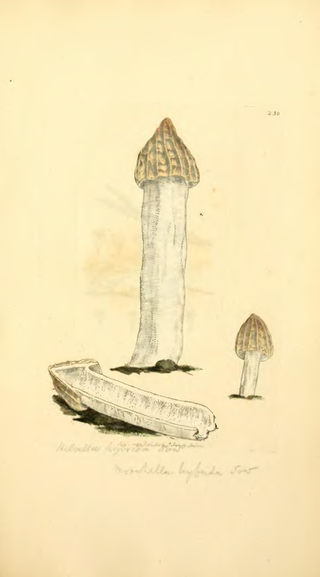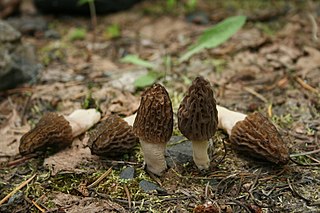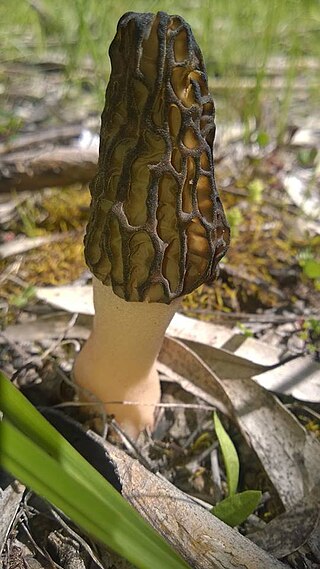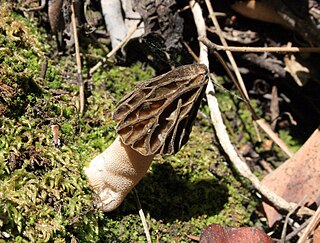
Morchella, the true morels, is a genus of edible sac fungi closely related to anatomically simpler cup fungi in the order Pezizales. These distinctive fungi have a honeycomb appearance due to the network of ridges with pits composing their caps. Morels are prized by gourmet cooks, particularly in Catalan and French cuisine. Due to difficulties in cultivation, commercial harvesting of wild morels has become a multimillion-dollar industry in the temperate Northern Hemisphere, in particular North America, Turkey, China, the Himalayas, India, and Pakistan where these highly prized fungi are found in abundance.

Morchella esculenta is a species of fungus in the family Morchellaceae of the Ascomycota. It is one of the most readily recognized of all the edible mushrooms and highly sought after. Each fruit body begins as a tightly compressed, grayish sponge with lighter ridges, and expands to form a large yellowish sponge with large pits and ridges raised on a large white stem. The pitted yellow-brown caps measure 2–7 centimetres broad by 2–10 cm (1–4 in) tall, and are fused to the stem at its lower margin, forming a continuous hollow. The pits are rounded and irregularly arranged. The hollow stem is typically 2–9 cm long by 2–5 cm (1–2 in) thick, and white to yellow. The fungus fruits under hardwoods and conifers during a short period in the spring, depending on the weather, and is also associated with old orchards, woods and disturbed grounds.

Gyromitra gigas, commonly known as the giants false morel, snow morel, snow false morel, calf brain, or bull nose, is a fungus and a member of the Ascomycota found in Europe. It is referred to as one of the false morels, due to its similar appearance and occurrence in the spring and early summer in similar habitats to true morels.

Gyromitra caroliniana, known commonly as the Carolina false morel or big red, is an ascomycete fungus of the genus Gyromitra, within the Pezizales group of fungi. It is found in hardwood forests of the southeastern United States, where it fruits in early spring soon after snowmelt.

Morchella elata is a species of fungus in the family Morchellaceae. It is one of many related species commonly known as black morels, and until 2012 the name M. elata was broadly applied to black morels throughout the globe. Like most members of the genus, M. elata is a popular edible fungus and is sought by many mushroom hunters.

Morchella rufobrunnea, commonly known as the blushing morel, is a species of ascomycete fungus in the family Morchellaceae. A choice edible species, the fungus was described as new to science in 1998 by mycologists Gastón Guzmán and Fidel Tapia from collections made in Veracruz, Mexico. Its distribution was later revealed to be far more widespread after several DNA studies suggested that it is also present in the West Coast of the United States, Israel, Australia, Cyprus, Malta and Switzerland.

Morchella semilibera, commonly called the half-free morel, is an edible species of fungus in the family Morchellaceae native to Europe and Asia.

Morchella americana is a North American species of fungus in the family Morchellaceae.

Morchella brunnea is a species of fungus in the family Morchellaceae. Described as new to science in 2012, it is known from Oregon, where it fruits under hardwood trees.

Morchella australiana is a species of ascomycete fungus in the family Morchellaceae. Described as new to science in 2014, it is found in New South Wales, South Australia,Tasmania and Victoria, Australia. The type locality was in the temperate Pilliga Scrub of northwestern New South Wales, west of the Great Dividing Range. Fruit bodies of the fungus resemble those of the European Morchella elata, but molecular and morphological analyses demonstrated that the Australian species represents a unique lineage.
Sanshi Imai was a Japanese mycologist of Hokkaido Imperial University.

Morchella arbutiphila is a species of fungus in the family Morchellaceae (Ascomycota), described from the island of Cyprus in 2016. The species is notable for its elongated stipe, which is often longer than the cap's length, its ascospores which are larger than most other species of Morchella, and its highly specific ecological preferences. It is known only from igneous substrates of the Troodos mountains in Cyprus and from a single collection in the Aegean region of Turkey.

Morchella disparilis is an Ascomycete fungus in the family Morchellaceae. Described as new to science in 2016, M. disparilis appears to be confined to the Mediterranean basin and is so far known from Cyprus, Greece and Spain. Its most striking feature is the exceptionally deep sinus, intermediate in depth between half-free morels of the Morchella semilibera clade and typical Distantes species.

Morchella fluvialis is a species of fungus in the family Morchellaceae. It was described as new to science in 2014 by Clowez and colleagues, following collections from riparian forests in Spain under Alnus glutinosa, Ulmus minor and Eucalyptus camaldulensis, although previous collections from Turkey under Pinus nigra have also been reported. This species, which corresponds to phylogenetic lineage Mes-18, is very close to Morchella esculenta, from which it differs in its elongated cap with oblong pits and predominantly longitudinal ridges, pronounced rufescence, as well as its Mediterranean hygrophilic distribution along rivers and streams.
Morchella palazonii is a species of morel found in Spain.
Morchella kakiicolor is a species of fungus in the family Morchellaceae (Ascomycota). It was originally proposed as a form of Morchella quercus-ilicis in a 2012 study by Philippe Clowez, but was later re-combined as an autonomous species by Loizides and colleagues, based on molecular phylogenetic data. In the same study, M. quercus-ilicis f. quercus-ilicis was shown by the authors to be a later synonym of the old taxon Morchella tridentina, and not phylogenetically related to M. kakiicolor.

Morchella eximia is a globally-occurring fungus in the family Morchellaceae (Ascomycota), first described by Émile Boudier in 1910. In an elaborate phylogenetic and nomenclatural revision of the genus in 2014, Richard and colleagues showed that the taxa Morchella anthracophila, Morchella carbonaria, and Morchella septimelata, proposed in 2012 by Clowez and Kuo et al. respectively, are all later synonyms of this old taxon.

Morchella dunensis, the morel of the dunes, is a species of fungus in the family Morchellaceae (Ascomycota). It was first described as a form of Morchella esculenta by Castañera and colleagues in 1996, but was later recombined as a distinct species by Clowez. In a 2014 study by Richard and colleagues, the authors concluded that the taxon was conspecific to Morchella vulgaris, due to its close phylogenetic proximity to the latter. However, following increased molecular sampling and the testing of an isoparatype collection by Loizides and colleagues in 2016, it was revealed that M. dunensis is indeed very closely related to, but phylogenetically distinct from M. vulgaris. This study also showed that the taxon Morchella andalusiae is phylogenetically identical and therefore a later synonym of M. dunensis.
Morchella casteneae is a species of fungus in the family Morchellaceae (Ascomycota). It was described as new to science in a 2012 study by Clowez and appears to be confined to the Iberian peninsula. A subsequent phylogenetic and nomenclatural study by Richard and colleagues has confirmed M. castaneae as a distinct species and showed the taxa Morchella brunneorosea and Morchella brunneorosea var. sordida to be synonymous.

Morchella sceptriformis is a species of fungus in the family Morchellaceae (Ascomycota). It was described as new to science in a 2012 study by Clowez, and corresponds to phylogenetic lineage Mes-3. Morchella virginiana, described later in the same year by Kuo and colleagues, is conspecific to this taxon.















